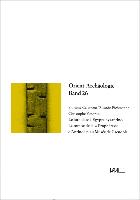Le Luth dans lÉgypte byzantine
BücherAngebote / Angebote:
Der Band bereichert das Wissen über bestimmte Aspekte spätantiker ägyptischer [koptischer] Musik und erlaubt, ausgehend von ikonographischen und literarischen Quellen, Einblicke in musikalische Praktiken der Zeit im ostmediterranen Raum und Vorderasien. Die Untersuchung geht aus von einer im frühen 20. Jh. von Albert Gayet im mittelägyptischen Antinoë ausgegrabenen Laute von nur 66, 7 cm Länge, die nicht mehr spielbereit, aber mit Schalen-Hals-Konstruktion, zwei von drei Wirbeln und einem Sattel mit Saitenführungskerben weitgehend vollständig erhalten war. Kerben für Holzbünde auf dem Griffbrett überliefern den einstigen Tonvorrat. Das Instrument wurde mit der mumifizierten Toten und allen Grabbeigaben [Glasobjekte, bemalte Keramik, Sandalen, Textilien, Isis-Figur, Vogelmumie etc.], eingehend multidisziplinär untersucht. Dabei ergab sich eine Herabdatierung in byzantinische Zeit [5./6. Jh.]. Auf der Laute konnten siebenstufige Tonleitern erklingen, rechts mit Ganztonfolgen und Dreivierteltonfolgen, die Bezüge zu Ptolemaios und persisch-arabischer Musik aufweisen, links mit kleiner Terz, Ganzton und Halbton. Identität und religiöse Zugehörigkeit der Verstorbenen bleiben unklar.
The volume enlarges our knowledge of certain aspects of Late Antique Egyptian [Coptic] music and, based on iconographic and literary sources, it provides insights into musical practices of the time in the Eastern Mediterranean and the Near East. The analysis is founded on an only 66.7 cm long lute excavated in Middle Egyptian Antinoe in the early 20th century by Albert Gayet. It was no longer in a playable state, but with its wooden bowl and neck, two of three tuning pegs and a nut with notches for directing the strings it survived almost completely. Positioning grooves for wooden frets indicate its musical potential in term of tones. The instrument, the mummified dead woman and all grave goods [glass objects, painted pottery, sandals, textiles, figure of Isis, bird mummy etc.] were subjected to intensive multi-disciplinary study. This resulted in a later dating into the Byzantine period [5th/6th century]. The lute was able to produce heptatonic scales consisting of whole tones and three-quarter tones on the right side, which are related to Ptolemy and Persian-Arabian music, and a minor third, a whole tone, and a semi tone on the left. The identity and religious affiliation of the deceased remain uncertain.
Folgt in ca. 2-3 Arbeitstagen




